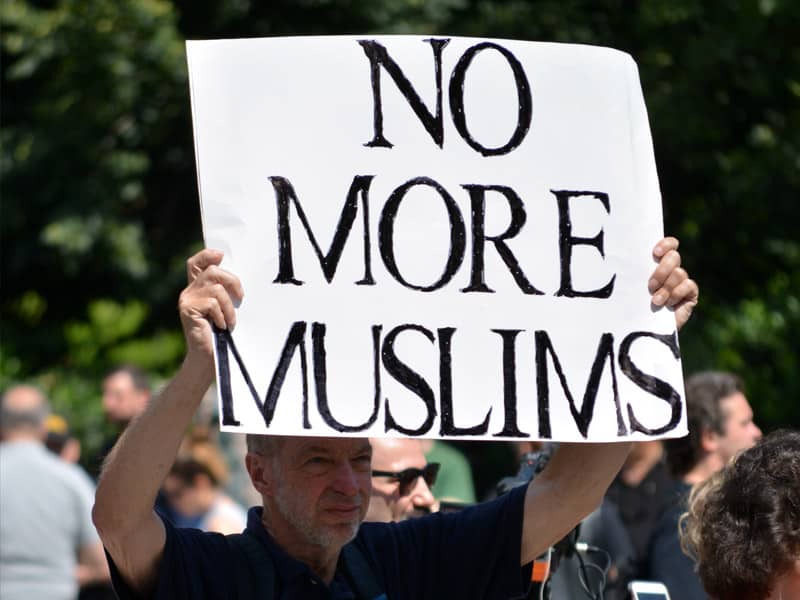It’s been my experience that most groups are humor-impaired when outsiders make fun of them. On MSNBC.com, readers were asked to vote on whether they thought the Muslim protests were justified. The vote was running 82 percent against the Muslim reaction when I checked Thursday night.
 |
| Click the image to open a gallery of Signe Wilkinson's cartoons |
I’m guessing the approval rating would plummet. Actually, I don’t need to guess because at various times in my career I’ve penned (and my newspaper has published) cartoons along those lines. Lack of humor ensued after each one. A number of my cartoons have caused boycotts, lost advertising for my newspaper, and elicited streams of phone calls and/or picketing in front of our building.
My editors have had to explain the nature of cartooning to the offended representatives of various faiths, ethnicities, and political groups. And I am not alone. Nearly all cartoonists worth their salt have enraged some portion of their readership, often when religious symbolism was part of the cartoon. While at least one colleague received death threats, most of the ensuing protests are loud, sometimes intimidating, but generally peaceful.
I don’t go out of my way to poke fun at the religiously faithful. I have no grounds to criticize other religions, when my own is such a quirky (though perfect) little cult. Unfortunately, cartoonists are easily bothered. I am particularly bothered when some group wants to impose its way of life on me--and most particularly when its adherents want my tax dollars to help them do the imposing. Religious groups are often among those asking for tax dollars, or particular laws to advance their interest or legalize their morality.
As the editor of the French newspaper France Soir noted after publishing the Danish cartoons, if we were to abide by all the rules of all the world’s religions, we wouldn’t be allowed to do much of anything.
I'll risk being called anti-Muslim to do my job
Read more on page 2 >>
| _Related Features | |
|
|
|
 |
Blacks weren’t alone in trying to influence how they were portrayed in popular culture. Long before 9/11, Arab-Americans asked for cartoonists to be more sophisticated in their depiction of Middle Easterners. Early in my career, I received a heads-up from an Arab-American group pointing out that all Arabs aren’t head-scarf-wearing sheikhs.
At several of our The Association of American Editorial Cartoonists conferences, representatives from Jewish, Latino, Arab, and other ethnic groups pled for relief from what they saw as derogatory stereotypes that we cartoonists routinely used as shorthand.
Our images have changed over the years, though many of us still draw sheikhs with scarves because they feature prominently in the news. If you wear dresses and scarves, cartoonists are going to draw you with dresses and scarves. But I think if you did a study--and I haven't--you'd find that more cartoons about the Middle East now feature Arabs who more resemble an American teenager at a mall.
Of course, sheikhs get to choose what they wear. Many women in Islamic societies don’t. My encounters with Muslims have mostly come over cartoons protesting the treatment of Muslim women. After one such cartoon, a local woman called me to defend the headscarf. I said I had no problem with anyone freely wearing a headscarf or any other religious outfit. I then asked her, "But you wouldn’t force other women to wear a headscarf, would you?"
After a pause she replied, "Well, if it was for her own good."
So there you have the reason I go to the drawing board every day. I am drawing to help prevent a world where someone else decides what I must wear for my own good. And, I’m willing to risk being called anti-Muslim to do it.
I’m guessing the Danish cartoonists were trying to do the same thing. The cartoons were criticizing violence and suicide bombing in the name of Islam. The cartoonists have the right to publish. And, in a free society, Muslims have a right to protest and publish their own cartoons in response. This is not a right granted to cartoonists or protesters in some Muslim countries.
I hope Muslims will come to know that they aren't the first, and won't be the last, to be offended by a political cartoon. I know cartoonists will take into consideration the reaction to this caricature when drawing their next ones on Muslim issues. If the reaction of the “Arab street” continues to be violence whenever they don’t like something they see in someone else's newspaper, then I predict more such cartoons are on the way. My suggestion is that instead of threatening to draw blood, Muslims should pick up their pens and draw return cartoons instead.
| _Related Features | |
|
|
|
 |

